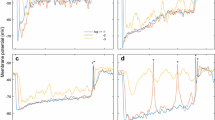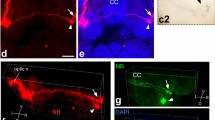Abstract
-
1.
The larva of the tiger beetle (Cicindela chinensis) possesses six stemmata on either side of the head. Optical and physiological properties of two pairs of large stemmata and a pair of anterior medium sized stemmata, and responses of second-order visual interneurons (medulla neurons) have been examined.
-
2.
Objects at infinite distance were estimated to focus 50 μm deep in the retina in the large stemmata. Receptive fields of four large stemmata, the acceptance angle of each being 90°, largely overlapped one another.
-
3.
The stemmata possessed a single type of retinular cell with a maximal spectral sensitivity at 525 nm, and a flicker fusion frequency of 25–50 Hz.
-
4.
Medulla neurons expanded fan-shaped dendrites in the medulla neuropil, and their axons extended into the protocerebrum. They responded to illumination with a variety of discharge patterns. They also responded with spike discharges to moving objects and to apparent movements provided by sequential illumination or extinction of LEDs. They did not show directional selectivity. They possessed well-defined receptive fields ranging from 30° to 105°.
Similar content being viewed by others
References
Bullock TH, Horridge GA (1965) Structure and function in the nervous systems of invertebrates, vol II. Freeman, San Fransisco London
Dartnall H (1953) The interpretation of spectral sensitivity curve. Br Med Bull 9: 24–30
Friederichs HF (1931) Beiträge zur Morphologie und Physiologie der Sehorgane der Cicindelinen. Z Morph Oekol Tiere 21: 1–172
Gilbert C (1989) Visual determinants of escape in tiger beetle larvae (Cicindelidae). J Insect Behav 2: 557–574
Hausen K, Egelhaaf M (1989) Neural mechanisms of visual course control in insects. In: Stavenga DG, Hardie RC (eds) Facets of vision. Springer, Berlin, pp 391–424
Hori M (1982) The biology and population dynamics of the tiger beetle, Cicindela japonica (Thunberg). Physiol Ecol Japan 19: 77–212
Ichikawa T, Tateda H (1982) Receptive field of the stemmata of the swallowtail butterfly Papilio. J Comp Physiol 146: 191–199
Meyer-Rochow (1974) Structure and function of the larval eye of the sawfly, Perga. J Insect Physiol 20: 1565–1591
Toh Y, Mizutani A (1994a) Structure of the visual system of the larva of the tiger beetle (Cicindela chinensis). Cell Tissue Res 278: 125–134
Toh Y, Mizutani A (1994b) Neural organization of the lamina neuropil of the larva of the tiger beetle (Cicindela chinensis). Cell Tissue Res 278: 135–144
Author information
Authors and Affiliations
Rights and permissions
About this article
Cite this article
Mizutani, A., Toh, Y. Optical and physiological properties of the larval visual system of the tiger beetle, Cicindela chinensis . J Comp Physiol A 177, 591–599 (1995). https://doi.org/10.1007/BF00207188
Accepted:
Issue Date:
DOI: https://doi.org/10.1007/BF00207188




